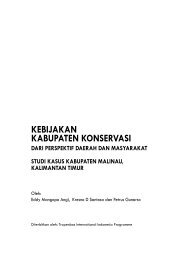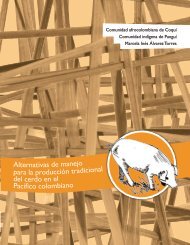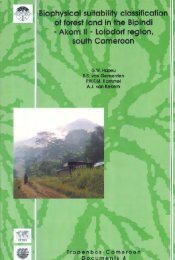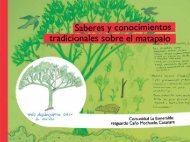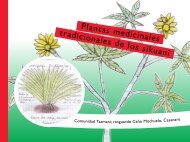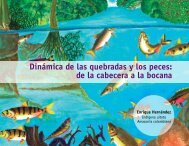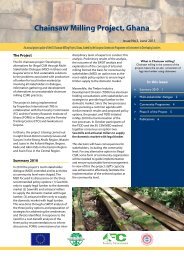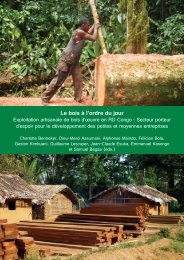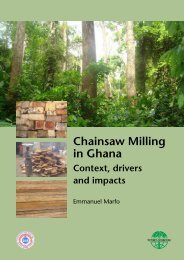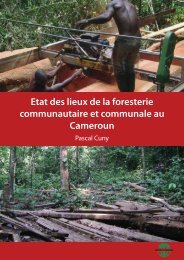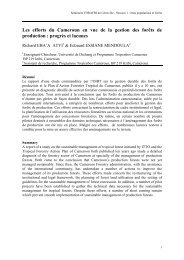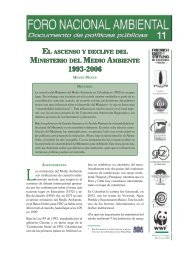Download the publication - Tropenbos International
Download the publication - Tropenbos International
Download the publication - Tropenbos International
You also want an ePaper? Increase the reach of your titles
YUMPU automatically turns print PDFs into web optimized ePapers that Google loves.
Plant diversity in a Central African rain forest: Implications for biodiversity conservation in Cameroon<br />
regional and evolutionary processes must in varying degree be taken into<br />
consideration to explain <strong>the</strong> high level of endemism and diversity recorded in <strong>the</strong><br />
area. Moreover, it is suggested that fur<strong>the</strong>r research to date <strong>the</strong> origin of endemic<br />
and slow dispersal species using recent modern molecular and phylogenetic<br />
(cladistic) techniques should be encouraged for a better understanding of <strong>the</strong><br />
evolutionary processes of tropical rain forest taxa.<br />
Ecological aspects of Aucoumea klaineana (Okoumé) at its nor<strong>the</strong>rn limit of<br />
distribution<br />
Okoumé is <strong>the</strong> most important timber species exploited in Gabon and accounts for<br />
over 90% of all timber export (White & Abernethy, 1997). In Gabon, it is a large<br />
canopy tree with winged seeds that by strong wind can be dispersed as far as several<br />
hundreds of metres from <strong>the</strong> parent tree. It tends to grow gregariously in stands with<br />
several individuals quite close toge<strong>the</strong>r. Their roots are often joined, which allow <strong>the</strong><br />
exchange of nutrients between individuals. In <strong>the</strong> Campo-Ma’an area, <strong>the</strong>se roots<br />
sometimes form a visible striking network on exposed rocks on hill slopes. Although<br />
its centre of frequency is found in Gabon, it reaches <strong>the</strong> nor<strong>the</strong>rn limit of its<br />
distribution in <strong>the</strong> Campo-Ma’an area and its sou<strong>the</strong>rn limit in western Congo.<br />
Okoumé is a light demanding species with very little or no regeneration capacity<br />
within <strong>the</strong> ecological environment presented by <strong>the</strong> lowland evergreen forest. Its<br />
frequent occurrence in Gabon is probably <strong>the</strong> result of savanna colonisation and<br />
forest disturbance in <strong>the</strong> past (White et al., 2000; Maley, 2002).<br />
Our study has demonstrated that <strong>the</strong>re are two different types of Okoumé<br />
communities in <strong>the</strong> Campo-Ma’an area. A more mature community is found at <strong>the</strong><br />
border with Equatorial Guinea, and a younger community exists on exposed rocks<br />
on hill slopes around Ebianemeyong and <strong>the</strong> Kom River in <strong>the</strong> National Park (Figure<br />
4.10). As shown in Table 4.3, <strong>the</strong>re was a significant difference between <strong>the</strong> number<br />
of Okoumé stems/ha recorded in <strong>the</strong> Ma’an (54 individuals in 0.2 ha) and<br />
Ebianemeyong forests (371 individuals in 0.2 ha). The Ebianemeyong community<br />
was characterised by an almost pure mono-dominant stand with many small and<br />
medium sized stems, and no stems above 80 cm DBH. The forest floor was open,<br />
completely covered by grasses, creeping Selaginella, terrestrial ferns, orchids and<br />
Begonia species. In <strong>the</strong> Ma’an community, <strong>the</strong>re was a gradual reduction of stems<br />
within <strong>the</strong> various DBH classes with more than 30 large Okoumé trees recorded<br />
with a diameter above 100 cm (in 0.2 ha). It is worth mentioning that <strong>the</strong>re are some<br />
30-40-year-old Okoumé plantations near Kribi between Bidou and Akok in <strong>the</strong><br />
Kienke Forest Reserve.<br />
Is <strong>the</strong> distribution of Okoumé under <strong>the</strong> present climatic conditions in Cameroon<br />
expanding or contracting? Pollen obtained from lake Ossa near Edea in south<br />
Cameroon showed that between 7500 and 3000 BP (mid Holocene) <strong>the</strong> distribution<br />
of Okoumé extended fur<strong>the</strong>r north towards <strong>the</strong> Sanaga River, reaching lake Ossa at<br />
about 170 km north of <strong>the</strong> present limit of distribution (Reynaud-Farrera et al.,<br />
1996; Maley, 2002). It is hypo<strong>the</strong>sised that <strong>the</strong> current distribution range of Okoumé<br />
is <strong>the</strong> result of <strong>the</strong> contraction of a wider spread population that existed during mid<br />
Holocene. During <strong>the</strong> severe arid period that occurred around 2500 BP, <strong>the</strong>re was a<br />
considerable reduction of <strong>the</strong> forest that may have resulted in <strong>the</strong> reduction of <strong>the</strong><br />
geographical range of Okoumé or in its fragmentation into small remnant patches<br />
78



